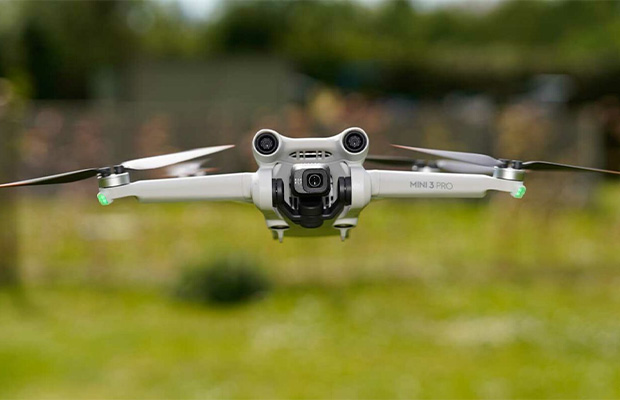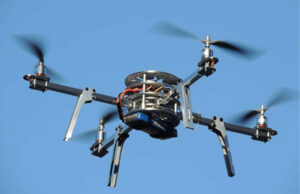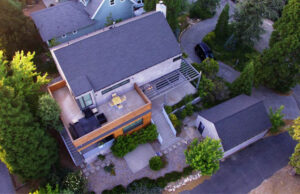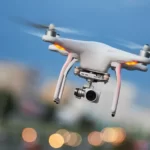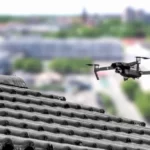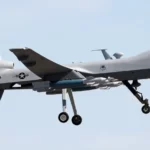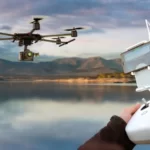The Mini series from DJI consists of small, easy-to-use drones that don’t need to be registered in the United States and are suitable for beginners. But does a small drone necessarily mean a small camera or vice versa? While adding a camera with a 1/1.3-inch sensor and an f1.7 lens, the DJI Mini Pro 3 maintains the same weight as previous mini models. In comparison to the Mini 2, it even adds more obstacle avoidance sensors.
The DJI Mini 3 Pro is one of the company’s smallest form factors, but it packs a powerful camera, a three-direction object avoidance system, and a plethora of features.
You have arrived at the ideal location if you are thinking about purchasing a DJI mini 3 Pro. Keep reading!
Table of Contents
Pros And Cons Of DJI Mini 3 Pro
Pros
- Incredibly small and lightweight
- Great camera
- Up-angle gimbal rotation
- Over 30 minute flight time
- Intelligent flight modes
- Longer battery life of 34 minutes
- Decent noise reduction at high ISOs
- 48 MP high-res mode also saves a DNG file
- Beautiful lens flare
- Compact design
- Easy for photographers who have never flown before
- Lots of pro options, including RAW, highlight alerts, and AEB
- Vertical shooting
Cons
- Not enough internal storage
- Smart flight modes don’t support vertical video
- Obstacle avoidance isn’t very good on the back and sides
- Fairly pricey
Design & Hardware Of DJI Mini 3 Pro
With the exception of the FPV, the Mini 3 Pro looks exactly like a scaled-down version of almost any other current consumer drone from DJI. It also has a dark gray propeller and an off-white body, so the color scheme is the same. There are recognizable folding arms, but unlike most earlier models, you don’t have to unfold them in a particular sequence. The lack of propeller mounts with springs, however, is a feature shared by the Mini family. On each set of propellers, you’ll need to remove a pair of screws with a screwdriver if they need to be replaced. Of course, if you can avoid hitting any trees or buildings, this won’t be a problem.
Of course, weight is what makes the Mini series unique. If a drone weighs 250g or more, many governments and regulatory bodies require registration. This model was created by DJI to fall just short of that weight requirement, at 249g or less. Remember that even if a country doesn’t require registration for a drone, the pilot may still need to have a license to fly in that country. For more information, consult the drone laws in your nation (or the nation(s) of destination).
The Mini 3 Pro is only about 2.5 inches tall and has a footprint similar to a large smartphone, like the Pixel 6 Pro, when the arms are folded. The loose pockets of a jacket or a pair of cargo shorts might be able to accommodate it. The controller is actually a little bit bulkier and heavier than the drone itself.
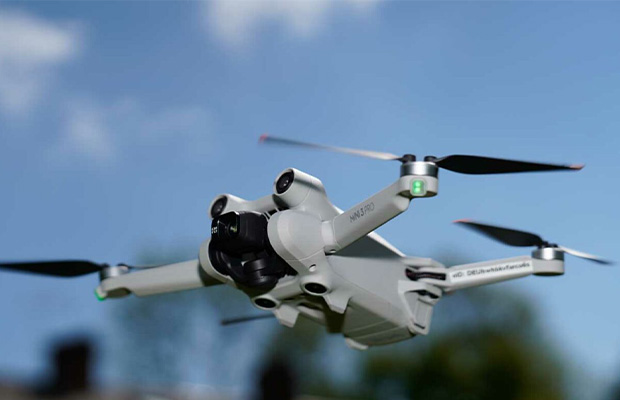
Build Quality Of DJI Mini 3 Pro
The Mini 3 Pro is extremely compact, as you can see in the pictures, but it still feels very sturdy and high-quality. It’s genius how the rotor arms fold out. I had to replace one of the eight blades for maintenance purposes, and it took me just two minutes and a small (included) screwdriver.
The Tri-Directional Obstacle Sensing cameras that DJI carries onboard detect obstacles in front, behind, and underneath the drone. The camera is housed in an ingenious Omni-directional housing that allows it to be controlled in both horizontal and vertical formats, as well as pan up and down and shoot directly down. The 24mm (35mm SLR format equivalent) f1.7 lens is used.
Initially, I didn’t quite understand why you would want to shoot vertically, but after speaking with a professional drone operator, he informed me that he now only shoots vertically because the majority of his work is viewed on phones and social media.
Finally, the dedicated controller is almost flawless and has a sturdy, responsive feel. If I had to criticize anything, it would be the way the controller’s bottom-mounted wells accommodate the detachable joysticks. It would be nice to have an extra stick in case you did lose them, even though you are probably not going to. The touch screen is also quite bright, but it would be helpful to have a hood or anti-reflective coating around it because it can be difficult to see in direct sunlight.
Flight Performance And Stability Of DJI Mini 3 Pro
Compared to its predecessor, the Mini 3 Pro’s design is slightly more geared toward forwarding motion, but other than that, it flies similarly to any recent Mavic drone. There isn’t much to it because flying any of the drones in this family is very simple and secure.
Like any drone, it will be pushed around by moderate to strong winds. The Mini 3 is somewhat more susceptible to strong winds because of its lightweight body, though. A heavier drone might be preferable if you need to hover precisely in one spot but the built-in gimbal can compensate for any shake the wind introduces. Let’s say the wind picks up after you’ve already taken off. In that case, the Mini 3 appears to be more able to fly into headwinds than the previous Mini model thanks to its redesigned body and stronger motors.
The larger models’ more robust obstacle avoidance is one feature I found lacking. The Mini 3 Pro has sensors that can detect obstructions from the front, bottom, and back; however, I didn’t find the rear sensor to be entirely reliable. These sensors have a reasonable amount of peripheral vision. Although most of them are disabled in intelligent flight modes, including lateral movement, there is still a sizable blind spot on the sides that won’t shield you.
Battery Life Of DJI Mini 3 Pro
Every generation sees a slight increase in flight times, and the Mini 3 Pro continues this trend by flying for 34 minutes as opposed to the Mini 2’s 31 minutes. Three minutes longer may not seem like much, but when you account for takeoff, landing, and the time it takes to frame a shot, that extra 10% becomes closer to 15% or 20% longer when it comes to shooting.
For those who require even more time, DJI also offers a “Flight Battery Plus” with a staggering 47-minute runtime. The combined weight of the battery and the standard model, however, is greater than the 250g limit that allowed the drone to operate without being registered.
Using the Mini 3 Pro’s standard battery, I was able to fly the device for up to 27 minutes while shooting 4K video before I had to bring it inside. It takes about an hour to recharge fully after that. At the time of review, the “Plus” battery wasn’t accessible for testing.
Image Quality Of DJI Mini 3 Pro
According to the “image parameters,” the DJI tech heads did a fantastic job with image quality. This is to say that viewing an unedited image on a 5K screen looks fantastic.
However when you start to zoom in / crop – you very quickly see the limitations of the 1/1.3″ (12mm) sensor and what would be a very cheap lens (and the reason high-end heavy lenses cost $3000+) When looking at narrow objects like powerlines or branches and shooting directly into the sun with expensive lenses, there was significant purple and magenta fringing from the white objects. Applying lens corrections in Lightroom is the expedient solution to this problem.
Noise is another thing that you’ll probably notice when enlarging an image, especially if you start to use a high ISO. However, because it is forbidden to fly at night or in low light, and because the aperture is a fixed f1.7, you will almost always be shooting at 100.
Contrary to many small drones, you can shoot in raw in both auto and manual modes, which is nice, but you have no control over aperture.
Although it would have been nice to have this feature given that the fixed f1.7 lens causes image sharpness falloff on the image edges, something that could be fixed by being able to stop down, I can’t really complain too much given that this is an entry-level device. The video looked great for the price range, with 4K images.
In the end, I believe the Mavic 3 Pro’s image quality is excellent, and you won’t notice aberrations when viewing it on the majority of screens (phone, laptop, etc.). Just be sure to crop in-camera by carefully positioning the drone.
Undoubtedly, a $40K drone setup would be used if you were filming a feature-length movie. However, for 80% of other applications, I believe it to be a strong performer for both video and stills, and if you work commercially, it is a very affordable way to add a “wow factor” to your image package.
Price Of DJI Mini 3 Pro
The Mavic 3 Pro costs $1119.00 when purchased with an RC-N1 Controller that connects to your phone. Or, for $1299, you can get the drone and a DJI RC Controller. The $259 “Fly More Kit” is an excellent addition. You obtain a perfect-sized leather/storage/carry pouch, two extra batteries, a triple battery charger, and even more replacement propellers.
Should You Buy DJI Mini 3 Pro?
Yes. Almost every requirement is met by the Mini 3 Pro. Being incredibly small and light, it is simpler to transport and is permitted to fly in many locations with little to no red tape. It supports 10-bit D-Cinelike for manual grading of your footage and has excellent image quality right out of the camera. Even more options are available now, and the flight time is among the best available. There wasn’t much else DJI could have added to this drone to make it better besides upgrading the cameras to either the Mavic 3 or Air 2S models.
Naturally, the total cost of all of this is $749; and that’s before purchasing a new RC remote, ND filters, the Fly More Kit (which regrettably does not include ND filters), memory cards, or other accessories. It’s worth the money, though, if you require the best image quality that can fit on a tiny drone.
But if you only fly for fun, is the money spent worthwhile? Most likely not, as DJI continues to offer the Mini 2, a fantastic option for $449. However, it might not satisfy pixel peepers. It still produces really good videos. On the other hand, anyone looking for the best video quality, regardless of the price or weight of the drone, should consider an Air 2S or a Mavic 3.
Buy It If:
- An extremely portable and light drone is what you need.
- You need a drone with an excellent camera.
- You want to have the option to purchase a controller with an integrated screen.
Don’t Buy If:
- You would be happy with a less expensive model like the Mini 2.
- The camera’s requirements from you are even higher.
Our Verdict
Possibly the best consumer drone on the market right now is the DJI Mini 3 Pro. The price can quickly rise to astronomical levels once you start considering switching to commercial options. Because of this, and especially for those who don’t anticipate flying frequently, this drone is a steal at its starting price of $1,119.
Read More:
FAQs
What Are The Differences Between DJI Mini 3 Pro And Mini 2?
Many of the differences between the two models are discussed in this review, but the camera quality is the primary selling point for the Mini 3 Pro. With a 1/1.3-inch sensor, higher resolution and framerate capabilities, and support for post-processing features, it offers a much larger sensor. The option of two controllers, a few extra minutes of battery life, and numerous other minor incremental improvements all help to improve this even further. However, the Mini 2 is more affordable at $449 compared to the Mini 3 Pro’s $749 price, making it more of an entry-level drone. This suggests that different types of buyers will likely be drawn to each drone.
What Are The Differences Between DJI Mini 3 Pro And Mavic Air 2?
When it first came out, the Mavic Air 2 was quite unique, in part because it could record video at 240 frames per second in 1080p, a feature that is still reserved for the much more recent Mavic 3. Beyond that, almost all other areas in which the Mini 3 Pro and Air 2 are comparable or superior to one another. If you could still purchase a brand-new Air 2, it would be slightly more expensive due to its larger size, heavier weight (requiring registration), smaller 1/2-inch camera sensor, and lack of features. Although DJI appears to have stopped selling this model directly, stores may still have some inventory on hand. The Air 2 may not be quite as good, but it will still produce a good image if you’re considering a used model at a good discount.
What Are The Differences Between DJI Mini 3 Pro And Air 2S?
The Air 2S is currently DJI’s second-best consumer drone, trailing only the bigger and more expensive Mavic 3. The Mini 3 Pro holds a very respectable third place in this ranking. The Air 2S (or Mavic 3) is probably the obvious choice if image quality is truly your top priority and the Mini 3 Pro won’t cut it. Due primarily to a larger 1-inch camera sensor, the Air 2S can record videos in a higher resolution of 5.2K and performs slightly better in challenging lighting conditions. Of course, the Air 2S has the same body as the Air 2, making it bigger, heavier, and requiring registration, but there aren’t many benefits beyond a little bit more stability on windy days. Since it costs less, is more portable, and doesn’t require registration, the Mini 3 Pro offers many of the same features.
